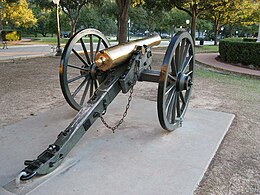Douglas's Texas Battery
The battery fought at Pea Ridge in March 1862 and soon afterward transferred to the east side of the Mississippi River.
James Postell Douglas replaced Good as commander and led the battery at Richmond, Stones River, Chickamauga, Chattanooga, the Atlanta Campaign, Franklin, and Nashville.
On 20 April 1861, Good accepted a captain's commission from Governor Edward Clark and was ordered to report to San Antonio.
When he returned to Dallas, Good found that the Confederate States of America authorized him to raise a battery of artillery, which he began recruiting.
[1] On 10 June 1861, Douglas's company left Tyler for Dallas carrying a flag made by the citizens of the town.
Benjamin McCulloch soon ordered the 3rd Texas Cavalry to continue its march and it participated in the Battle of Wilson's Creek in 13 August.
However, Greer's rapid march through Indian Territory had damaged the equipment of Good's Battery to such an extent that it was compelled to halt at Fort Smith and effect repairs.
[4] Good's Battery fought at the Battle of Pea Ridge on 7–8 March as part of a division led by McCulloch.
On 7 March, Price's division made some progress, but the Leetown attack failed; McCulloch and another general were killed and a third leader captured.
[6] At about 4:00 pm, Albert Pike assumed command of McCulloch's division and marched to join Price with 2,000 troops and Good's Battery.
[7] The morning of 8 March revealed 21 Federal cannons under Franz Sigel in a position overlooking the Confederate right flank near Elkhorn Tavern.
When Good's Battery exhausted its ammunition, the men limbered up the guns and withdrew, leaving the flag behind in their haste.
Since Price's Missourians led the retreat, McCulloch's men found very little to eat until the army crossed the Boston Mountains into central Arkansas.
Good fell ill and resigned his command on 10 May 1862, the same day that the battery reorganized; he later served as a military judge.
When Douglas allowed his tired cannoneers to ride on the caissons and gun carriages, he was placed under arrest by Preston Smith, his brigade commander.
[16] At the Battle of Stones River on 31 December 1862–2 January 1863, Douglas's Battery served with Mathew D. Ector's brigade in John P. McCown's division of William J. Hardee's corps.
[17] At the start of the Confederate attack on the first day, Douglas's Battery was positioned on the left flank of McCown's division.
He noticed a group of Union soldiers about 150 yd (137 m) distant who failed to identify his battery as an enemy unit.
[18] Douglas's Battery next fought in the Battle of Chickamauga on 19–20 September 1863 as part of the artillery battalion belonging to Cleburne's division of Daniel Harvey Hill's corps.
When the unit finally reached a clearing, it was targeted by two Federal batteries, so Douglas ordered it back behind a hill.
[29] In the Nashville campaign, Douglas commanded the artillery battalion while the Texas Battery was led by Lieutenant Hardin.
Edward Hatch's Union cavalry first scattered Buford's horsemen and, aided by darkness, managed to get among Stevenson's infantry in a confused melee.
[29] Dabney H. Maury and 10,000 Confederate soldiers with 300 guns defended Mobile against 45,000 Federal troops under Edward Canby in March and April 1865.



